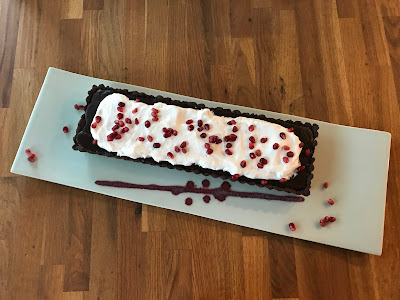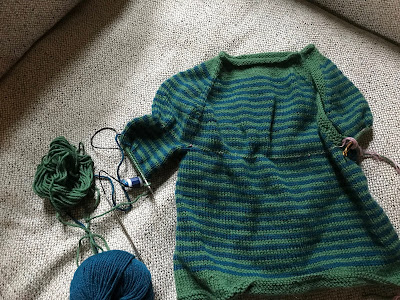

This chocolate tart is vegan and free of refined sugar and gluten, but that’s besides the point. I had first seen it here, but I am not crazy about crusts made out of chopped nuts, so when I saw it again here with a grain-free flour crust, I was in. It just so happened that I had all the necessary ingredients on hand, and since I wanted a gluten-free dessert for Thanksgiving, this was perfect (it would also be perfect for Christmas, just saying). You can easily make it a day ahead and keep it in the fridge until you are ready to serve it.
I changed the ingredients a bit, replacing some of the water of the filling with maple syrup, and I’m definitely recommending my way (below). That being said, as in the original recipe, there is too much filling for the crust, so what’s leftover can be refrigerated in ramequins and served as chocolate pudding. I’m sure I could fiddle with the quantities and get it just right, but who has time? I also use CocoWhip instead of making my own whipped coconut topping, because I’m never satisfied with the latter.
For the crust
½ cup (80 g) sweet white rice flour
½ cup (60 g) blanched almond flour
½ cup (45 g) cocoa powder
2 Tbsp. (12 g) tapioca flour (tapioca starch)
¼ cup (50 g) organic granulated cane sugar
¼ tsp. fine sea salt
6 Tbsp. (85 g) cold vegan butter (such as Miyoko’s or Earth Balance), diced into ½” cubes
1 tsp. vanilla extract
1 ½ oz dark chocolate, very finely chopped or grated
For the filling
1 ½ cups (225 g) raw cashews, soaked in cool water for 4-12 hours (or covered in boiling water and soaked 1-2 hours)
¾ cup (75 g) cocoa powder
2 Tbsp. (10 g) finely ground chia seed (use a spice grinder)
1 cup maple syrup
¾ cup water
1/8 tsp. fine sea salt
1 tsp. vanilla extract
½ cup + 2 Tbsp. (130 g) melted extra-virgin coconut oil
For the assembly
1 container of CocoWhip
pomegranate arils
dark chocolate shavings
For the crust
Position a rack in the center of the oven and preheat to 350 °F.
In the bowl of a stand mixer fitted with the paddle attachment, combine the sweet rice and almond flours with the cocoa powder, tapioca starch, sugar, and salt. Scatter the butter pieces over the top and drizzle with the vanilla extract. Turn the mixer to medium-low and run until the dough comes together in clumps and the butter is worked through, 3–5 minutes. (It will seem as though the dough won’t come together, but don’t worry – it will!)
Dump about half of the crumbs into a 5x13-inch rectangular loose-bottom tart pan (or 9-inch round tart pan) and press evenly into the sides of the pan. Add the remaining crumbs and press evenly into the bottom – it usually takes me a few minutes to make it look pretty.
Place the pan on a rimmed baking sheet to catch any drips and bake until slightly puffed and firm to the touch, 20-25 minutes. Remove the crust from the oven and, while it’s still hot, press the sides and bottom with the back of a spoon. (This will help it hold together when cool.) While the crust is still hot, scatter the chocolate in the bottom and let sit a few moments to melt. Use the back of a spoon or an offset spatula to spread the chocolate over the bottom and sides of the crust. Let cool completely.
For the filling
In the bowl of a blender (preferably high-speed, like a Vitamix) or food processor, combine the soaked and drained cashews, cocoa powder, ground chia seed, maple syrup, water, salt, and vanilla. Blend until very smooth, starting on low and gradually increasing to high, about 2 or 3 minutes in a high-speed blender and longer if needed. Add the coconut oil and blend briefly until smooth. Pour the filling into the crust; you’ll have about a cup left over to chill and eat as pudding. Chill the tart until firm, at least 4 hours and up to a day or two.
For the assembly
When ready to serve, remove the sides from the tart pan and place the tart on a serving board or platter. Top with CocoWhip and sprinkle with pomegranate arils and dark chocolate shavings (optional). To serve, use a large, sharp chef’s knife dipped in hot water and wiped clean between cuts to cut the tart into slices or wedges and serve. The tart will keep, refrigerated airtight, for up to several days.


















































